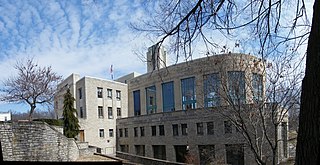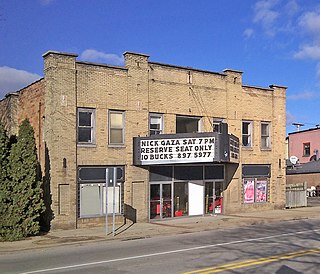
The Bristol Commercial Historic District is a national historic district in Bristol, Tennessee and Bristol, Virginia.

The Old Downtown Harrisburg Commercial Historic District is a national historic district that is located in Harrisburg, Dauphin County, Pennsylvania.

Warsaw Downtown Historic District is a national historic district located at Warsaw in Wyoming County, New York. The district encompasses 36 contributing buildings in the village of Warsaw. They are a variety of commercial, institutional, and religious buildings with most built between the 1870s and 1915. A number of commercial buildings were constructed after the fires of 1867 and 1887. They include the Andrew Jackson Warner designed United Church of Warsaw (1860s), First Baptist Church (1889), Bartlett Block, Hostetter's Pharmacy, New Watkin's Hotel Sullivan Building (1915), Wyoming County Bank, Glover's Department Store, Gardner's Grocery, Pratt Grocery, Farman-Humphrey Block (1884), Lincoln Block, and Schwab's Motor Sales. Located in the district and separately listed are the Warsaw Academy and United States Post Office.

Downtown Elkin Historic District is a national historic district located at Elkin, Surry County, North Carolina. The district encompasses 51 contributing buildings and 2 contributing structures in the central business district of Elkin. They were primarily built between about 1890 and 1950 and include notable examples of Early Commercial and Bungalow / American Craftsman architecture. Notable buildings and structures include the Gwyn-Foard House, Hugh G. Chatham Bridge (1931), Liberty Tobacco Warehouse, Harris Building (1902), U.S. Post Office (1937) designed by the Office of the Supervising Architect under Louis A. Simon, former Elkin Town Hall (1938–1939) built by the Works Progress Administration, Dobbin's Store, and the Riverside Hotel (1915–1925).

Broadway Historic District is a national historic district located at Lancaster in Erie County, New York. The district encompasses 85 contributing resources in the village of Lancaster. The district includes a variety of commercial, residential, religious and institutional buildings built between about 1831 and 1940. It includes notable examples of Greek Revival, Italianate, Queen Anne, Colonial Revival, and Bungalow / American Craftsman style architecture. Located in the district are the separately listed Lancaster Municipal Building (1940), Miller-Mackey House, Clark-Lester House, Bruce-Briggs Brick Block, Lancaster Masonic Lodge Hall (1916-1919), Liebler-Rohl Gasoline Station, Dr. John J. Nowak House, Zuidema-Idsardi House, Herman B. VanPeyma House, and John Richardson House. Other notable buildings include the Seeger Store Building, Brost Building designed by Edward Brodhead Green, Maute House, Depew Lancaster Moose Lodge No. 1605 B.P.O.E. Lodge/Potter's Hall, and Lancaster Presbyterian Church (1832-1833).

State and Prospect District is a national historic district located at Indianapolis, Indiana. The district encompasses eight contributing buildings and one contributing object in the Fountain Square Commercial Areas of Indianapolis. It developed between about 1871 and 1932, and notable buildings include the Mitschrich / Schaefer Feed Store, Sommer / Roempke Bakery, and Lorber's Saloon (1885).

Jackson Uptown Commercial Historic District is a national historic district located at Jackson, Cape Girardeau County, Missouri. The district encompasses 23 contributing buildings in the central business district of Jackson. It developed between about 1880 and 1953, and includes representative examples of Classical Revival style architecture. Notable buildings include the Cape Girardeau County Savings Bank, Kertsners's Drug Store, Cape Girardeau County Courthouse designed by P.H. Weathers, and Jones Drug Store.

Broadway Commercial Historic District is a national historic district located at Cape Girardeau, Cape Girardeau County, Missouri. The district encompasses 35 contributing buildings and 1 contributing structure in a predominantly commercial section of Cape Girardeau. It developed between about 1868 and 1965, and includes representative examples of Queen Anne, Mission Revival, and Art Deco style architecture. Located in the district is the separately listed Julius Vasterling Building, the Esquire Theater, and the Broadway Theater. Other notable buildings include the Star Service Station (1965), Phil C. Haman Drug Store (1927), Haman's Shoe Store (1910), Finney's Drug Store, Broadway Prescription Shop, Kroger Super Market (1948), Kroger Super Market Parking Lot (1948), Pete Koch's Sinclair Service Station (1954-1955), Bell Telephone Company (1963), American Legion Building (1920-1923), and Vandeven Mercantile.

Harrisonville Courthouse Square Historic District is a national historic district located at Harrisonville, Cass County, Missouri. The district includes 34 contributing buildings, 1 contributing structure, and 1 contributing object in the central business district of Harrisonville. It developed between about 1880 and 1943, and includes representative examples of Italianate, Queen Anne, Colonial Revival, Tudor Revival, and Renaissance Revival style architecture. Notable buildings include the Cass County Courthouse (1897), New Method Laundry (1929), Cass County Democrat, Wooldridge Building, Bank of Harrisonville (1900-1901), Wirt's Opera House Building, Post Office Building (1925), Emmons Building/Bowman Building (1887), Evans Building (1890), White Motor Company, Stephen Stuart "Racket" Store, First National Bank of Harrisonville, and Deacon Building (1892).

Excelsior Springs Hall of Waters Commercial East Historic District is a national historic district located at Excelsior Springs, Clay County, Missouri. It encompasses 24 contributing buildings and 2 contributing structures in the central business district of Excelsior Springs. The district developed between about 1894 and 1948 and includes representative examples of Victorian architecture. The central feature of the district, the separately listed Hall of Waters, is a five level, Art Deco / Depression Modern style reinforced concrete building. Other notable buildings include the Flanders Dry Goods Store, A.M. Howard Drug Store (1905-1909), Clay County State Bank (1906), The Huey Building (1908), Oriental Bazaar Gift Store (1908), The Excelsior Baths and Broadway Rooms, Fraternal Order of Eagles Lodge Hall, The Kennedy Building (1902), First National Bank Building, The Francis Hotel, and The Auditorium.

Munichburg Commercial Historic District is a national historic district located at Jefferson City, Cole County, Missouri. It encompasses nine contributing buildings in Jefferson City. The district developed between about 1892 and 1951, and includes representative examples of Early Commercial and One and Two Part Commercial architecture. Notable buildings include the Nieghorn House Hotel (1892), Southside Barber Shop, Schmidt Shoe Store (1908), Southside Dry Goods, Milo H. Walz Hardware Store, Milo H. Walz Furniture Store (1936), Henry Schmidt Grocery Store, Central Dairy, and Busch's Florist.

New Haven Residential Historic District is a national historic district located at New Haven, Franklin County, Missouri. The district encompasses 26 contributing buildings a predominantly residential section of New Haven. The district developed between about 1857 and 1945, and includes representative examples of Italianate, Queen Anne, Colonial Revival, and Bungalow / American Craftsman style architecture. Notable buildings include the Langenberg Hat Factory, William H. Otto Furniture Store, Central Hotel, Dr. John S. Leewright House (1857), Lillie Patton House, Richard Schure House, George Wolff Sr. House (1880), Edward Hebbeler House (1916), and Emil Wolff House.

Campbell Avenue Historic District is a national historic district located in Springfield, Missouri, United States. The district encompasses 11 contributing buildings in a commercial section of Springfield. The district developed between about 1885 and 1948, and it includes representative examples of Italianate and Colonial Revival style architecture. Notable buildings include the McLaughlin Block and Busy Bee Department Store.

Springfield Public Square Historic District is a national historic district located at Springfield, Missouri, United States. The district encompasses 27 contributing buildings, 1 contributing site, 1 contributing structure, and 2 contributing objects in Springfield's central business district. The district developed between about 1890 and 1959, and includes representative examples of commercial architecture. Located in the district are the separately listed Franklin Springfield Motor Co. Building, Gillioz Theatre, Heer's Department Store, Netter-Ullman Building, and Marx-Hurlburt Building. Other notable resources include the Landers Building (1915), F. W. Woolworth Co. (1954), J. J. Newberry Co. (1951), S. S. Kresge Co. (1953), Springfield Cigar Company, Stancill Drug Store, National Shirt Co, Salvation Army, Public Square, Queen City Bank (1914), Frisco Office Building (1910), and Cantrell Building.

Clinton Square Historic District is a national historic district located at Clinton, Henry County, Missouri. The district encompasses 62 contributing buildings, 1 contributing structure, and 1 contributing object in the central business district of Clinton. It developed between about 1885 and 1957 and includes representative examples of Italianate and Romanesque Revival style architecture. Located in the district is the separately listed Anheuser-Busch Brewing Association Building. Other notable buildings include the Fristoes Body Shop Office, Whitehead Consultants, Texas Room / Pit Stop Pub, State Farm Insurance, Montgomery Ward (1940s), J.C. Penney / Brownsbergers / Eberting's Main Street Central, Old City Hall (1891), Delozier Building (1887), Crest Cinema, Henry County Courthouse, and the Bandstand on Courthouse Square.

Glasgow Commercial Historic District is a national historic district located at Glasgow, Howard County, Missouri. The district encompasses 31 contributing buildings in the central business district of Glasgow. It developed between about 1867 and 1940 and includes representative examples of Second Empire, Italianate, and Queen Anne style architecture. Notable buildings include the Old City Hall (1867-1868), W. A. Meyer Grocery (1879), Henderson's Drug Store (1875), and Bank building/City Hall (1883).

New Franklin Commercial Historic District, also known as Downtown New Franklin, is a national historic district located at New Franklin, Howard County, Missouri. The district encompasses 19 contributing buildings and 1 contributing object in the central business district of New Franklin. It developed between about 1894 and 1931 and includes representative examples of Queen Anne and Romanesque Revival style architecture. Notable contributing resources include the John B. and Logie R. Fleet House, U.S. Post Office, Home Electric Company Office, Carpenter and White Building, Bethke's German Cash Store (1909), Citizen's Bank (1894), and Santa Fe Trail Marker (1913).

Joplin Downtown Historic District is a national historic district located at Joplin, Jasper County, Missouri. The district encompasses 48 contributing buildings in the central business district of Joplin. It developed between about 1883 and 1958 and includes representative examples of Mission Revival, Art Deco, and Modern Movement style architecture. The district includes the previously listed Fifth and Main Historic District, Newman Brothers Building, Fox Theater, and St. Louis and San Francisco Railroad Building. Other notable buildings include the Liberty Building (1923), Cunningham Bank / Quinby Building, Model Clothing Store Building, Lichliter-Kassab Building, Zelleken Block, Muenning Building, and Frank Hollcroft Livery Building.

Downtown Webb City Historic District is a national historic district located at Webb City, Jasper County, Missouri. The district encompasses 43 contributing buildings in the central business district of Webb City. It developed between about 1883 and 1965 and includes representative examples of Italianate, Renaissance Revival, Romanesque Revival, Art Deco, and Streamline Moderne style architecture. Located in the district is the previously listed Middle West Hotel. Other notable buildings include the National Bank, S. Morris Department Store, Morris Opera House and Royal Furniture Co., The Unity Building and Merchant and Miners Bank, Aylor Building / Odd Fellow Hall, Mystic Theater, Newland Hotel, Dickenson Theater, Civic Theater, U.S. Post Office, and the Old U.S. Post Office / Wagner Building.

The Downtown Lowell Historic District is a primarily commercial historic district located along Main Street (M-21), roughly between Hudson and Washington Streets, in Lowell, Michigan. The district was listed on the National Register of Historic Places in 1999.
























